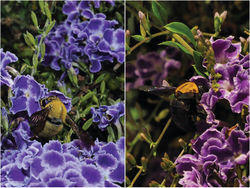Xylocopa pubescens
| Notice: | This page is derived from the original publication listed below, whose author(s) should always be credited. Further contributors may edit and improve the content of this page and, consequently, need to be credited as well (see page history). Any assessment of factual correctness requires a careful review of the original article as well as of subsequent contributions.
If you are uncertain whether your planned contribution is correct or not, we suggest that you use the associated discussion page instead of editing the page directly. This page should be cited as follows (rationale):
Citation formats to copy and paste
BibTeX: @article{Ruiz2020JournalofHymenopteraResearch80, RIS/ Endnote: TY - JOUR Wikipedia/ Citizendium: <ref name="Ruiz2020Journal of Hymenoptera Research80">{{Citation See also the citation download page at the journal. |
Ordo: Hymenoptera
Familia: Apidae
Genus: Xylocopa
Name
Xylocopa pubescens Spinola, 1838 – Wikispecies link – Pensoft Profile
New records
Spain: Canary Islands, Gran Canaria, Las Palmas de Gran Canaria. 1 ♀ Ciudad Jardín, 11 Jun. 2020, Kings Ruly obs.; several ex. Parque Doramas, 28.120, -15.428, Jun. 2020, Pablo Martínez Darve obs.; 1 ♀ Mercado central, 06 Jul. 2020, 28.133,-15.432, Manuel Betancor obs.; 1 ♀ Playa de las Canteras, 28.142,-15.432, 18 Aug. 2020; 1 ♀, 1♂ Parque Doramas, 28.120, -15.428, 2 Oct. 2020, Manuel Arechavaleta obs.; 4 ♀, 5 ♂, Parque de La Ballena, 28.1052, -15.4424, 30 Sept. 2020, M. Naranjo obs.; 1 ♀, 1♂ Urbanización Las Filipinas, 28.0761, -15.4198, 25 Sept. 2020, M. Naranjo leg.
Spain: Canary Islands, Gran Canaria, Maspalomas. 1 ♀ Playa del Inglés, 27.749, -15.578, 05 Sep. 2020, Carlos Velázquez Padrón leg.
Identification
Xylocopa pubescens was identified at subgenus level (Koptortosoma) by its external morphology. It is morphologically unique among Canary Island bees; the only species of Xylocopa on the archipelago is X. violacea. From this last species, X. pubescens can be easily differentiated by the mesosoma covered dorsally with yellow hairs. Males are smaller than females, and they can be distinguished by a narrow head and yellow pubescence covering their entire body (Fig. 1). However due to morphological similarities with related species such as X. modesta Smith, 1854 from Cape Verde, X. aestuans (Linnaeus, 1758) from Southeast Asia or X. appendiculata Smith, 1852 (introduced in North America), a molecular identification through barcode was accomplished. An individual from Las Palmas de Gran Canaria city was successfully sequenced for the barcode region of mitochondrial cox1. Sequence length was 658 bp (0% ambiguities) with no evidence of stop codons or NUMTs. Comparison with the DNA barcode library using the BOLD ID Engine resulted in a 99.35% of similarity with an exemplar of X. pubescens from Fes-Boulemane Region (Rif region, North of Morocco). Individuals from Cyprus and Israel showed lower similarity (99.23–99.07%). NCBI Blast resulted in 97.26% of similarity with the related species Xylocopa aestuans.
Taxon Treatment
- Ruiz, C; Suárez, D; Naranjo, M; Rúa, P; 2020: First record of the carpenter bee Xylocopa pubescens (Hymenoptera, Apidae) in the Canary Islands confirmed by DNA barcoding Journal of Hymenoptera Research, 80: 169-175. doi
Images
|
